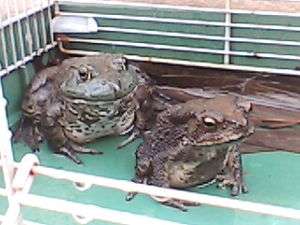Frogs in captivity

Frogs have recently become very popular exotic pets as they are generally undemanding, often visually appealing, and can be kept under fairly basic conditions, compared to reptiles. Many frogs, especially small ones, are inexpensive, and their food is in most cases easily purchased. Commonly kept pet frogs include ranids, hylids, bufonids, leptodactylids, and dendrobatids.
Feeding
Pet frogs can be fed a wide variety of live foods, from pinhead crickets to mice and rats, depending on the size of the frog. Particularly small pet frogs, like those of Dendrobates and Phyllobates species, will generally feed on small crickets, fruit flies, springtails, and other small arthropods. Medium-sized pet frogs can be fed larger crickets, mealworms, butterworms, silkworms, grasshoppers, and even small fish. Large pet frogs, like those in the genus Ceratophrys can be fed small fish, other frogs, reptiles, and small mammals such as mice or rats.
Housing

Depending on the size and nature of the frog, the size of terrariums in which they can be kept varies widely. Small or sluggish frogs can be kept in 60 x 30 x 30 cm terrariums; the highly active dendrobatids are an exception as they like to climb; dendrobatids generally need a terrarium of about 1 m x 60 cm x 60 cm. Large frogs, on the other hand, may need a terrarium measuring 1 m in each direction. Some arboreal frogs, such as dendrobatids, can stick to glass; these frogs require terrariums with sealed tops to prevent escape. Tropical frogs also often require an air flow; cages with metal mesh on at least two walls should provide them with enough air flow. All pet frogs require moisture; this can be provided either with an automatic fog machine or by a hand-held spray bottle. Frogs that live in the jungle naturally must be misted at least twice per day; frogs native to drier areas do not require as much moisture. Pools of clean water must also be provided; water with chlorine in it can damage the frogs. Bottled water should be used instead to fill the frogs' pools.
See also
External links
- All About Frogs: Species Caresheets : Information on Specific Breeds of Frogs and Toads
- Ask Questions and get answers from experts : Dart Frog Experts